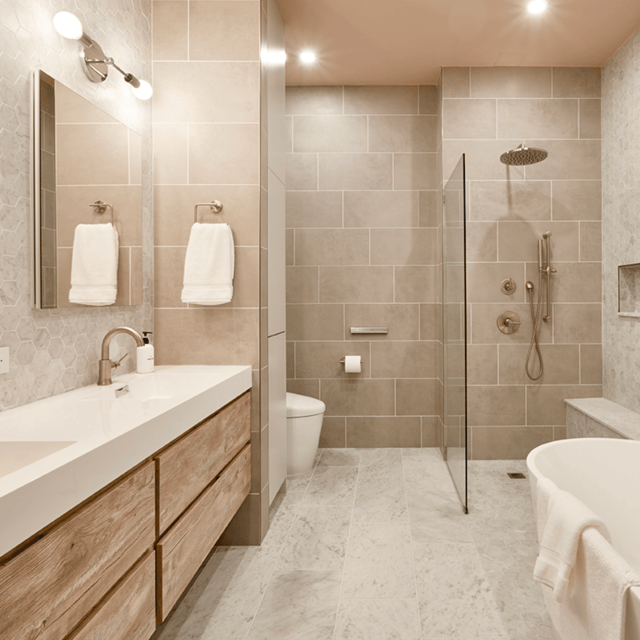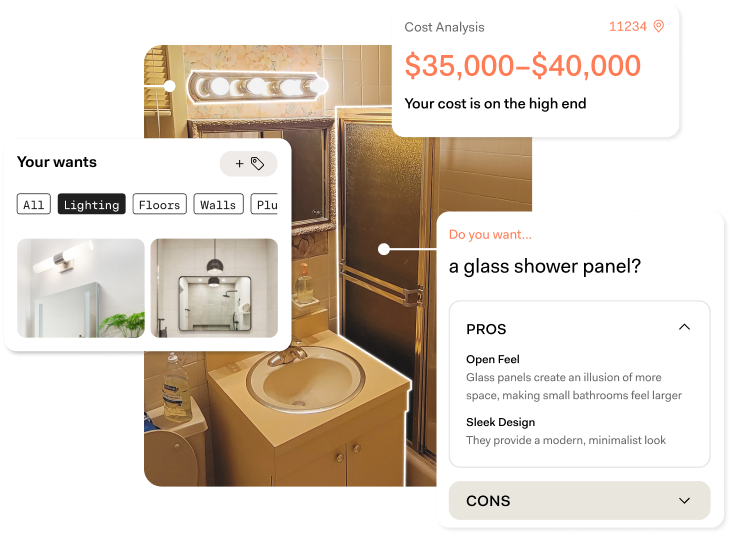
Bathroom
New York City Bathroom Remodels: Planning & Renovation Tips
12.05.2025


In This Article
A bathroom redesign can breathe new life into your home, turning a once dull and outdated space into a luxurious and functional oasis. If you've been asking yourself, "how can I redesign my bathroom?", this step-by-step guide will walk you through the entire process, from initial planning to final touches, ensuring a smooth and stress-free bathroom transformation. With expert tips and tricks, you'll be well on your way to achieving your dream bathroom.
Before embarking on your bathroom redesign journey, it's crucial to have a clear understanding of your goals and objectives. Consider factors such as functionality, aesthetics, and accessibility, as well as any specific features or elements you'd like to incorporate.
Once you have a clear vision of your dream bathroom, establish a realistic budget to guide your decision-making throughout the process. Consider costs for materials, labor, and any unexpected expenses that may arise. Allocate funds for each aspect of your renovation, such as fixtures, flooring, and lighting, and be prepared to make adjustments if necessary to stay within your budget. Keep in mind that investing in high-quality materials and fixtures will result in a more enjoyable and long-lasting bathroom redesign.
With your goals and budget in mind, begin researching and gathering inspiration for your bathroom redesign. Browse home design websites, magazines, and social media platforms such as Pinterest and Instagram for ideas and trends. Create a mood board or digital collection of images, materials, and fixtures that resonate with your desired aesthetic.
As you research, pay attention to elements that can enhance the functionality and comfort of your bathroom, such as smart storage solutions, energy-efficient fixtures, and ergonomic design principles. Additionally, consider the latest trends in bathroom design, such as spa-like features, freestanding bathtubs, and bold, statement tiles.
The layout and design of your bathroom play a significant role in its overall functionality and appeal. Evaluate your existing layout and identify any areas for improvement. Consider factors such as traffic flow, storage, and accessibility. Research different bathroom layout options and consider which one best suits your space and needs. Popular layouts include the three-wall layout, the two-wall layout, and the one-wall layout. Each option has its advantages and drawbacks, so weigh the pros and cons before making a decision.
Maximize the available space in your bathroom by utilizing vertical storage, incorporating built-in shelves, or installing wall-mounted fixtures. Additionally, consider using lighter colors, glass shower enclosures, and strategically placed mirrors to create the illusion of a larger space.
Choose the materials, colors, and fixtures that align with your desired aesthetic and budget. Consider the durability and maintenance requirements of each material, and prioritize quality and longevity in your selections. Some common materials used in bathroom redesigns include tile, natural stone, and wood.
When selecting fixtures, consider options such as faucets, showerheads, toilets, and lighting fixtures. Pay attention to factors such as water efficiency, durability, and style. Ensure that the materials and fixtures you choose work together harmoniously to create a cohesive and visually appealing design.
Hiring a reputable contractor is essential for a successful bathroom redesign. Research local contractors who specialize in bathroom renovations, read reviews, ask for recommendations from friends and family, and check their credentials and licensing. Request quotes from multiple contractors to compare their pricing and scope of work, which will help you find a professional who offers the best value for your budget. Contact previous clients of your shortlisted contractors to inquire about their experience and satisfaction with the work completed, which will give you a better understanding of the contractor's reliability, communication, and quality of work.
Once you've chosen a contractor, sign a detailed contract outlining the scope of work, timeline, payment terms, and any warranties or guarantees. This will help protect both parties in the event of any disputes or issues that may arise during the renovation process.
Stay actively involved in the construction process, maintaining regular communication with your contractor and addressing any concerns or changes that may arise. Establish a clear plan for debris removal and ensure your contractor has easy access to the work area.
Monitor the progress of your bathroom redesign, and don't hesitate to ask questions or request updates from your contractor. This will help ensure that your project stays on track and meets your expectations.
Once the construction phase of your bathroom redesign is complete, it's time to add the finishing touches that will truly make the space your own. Choose accessories, such as towels, bath mats, and artwork, that complement your chosen materials and fixtures. Install storage solutions, like shelving or cabinets, to keep your bathroom organized and clutter-free.
By following this step-by-step guide, you'll be well-equipped to redesign your bathroom with confidence and ease. From initial planning to final touches, you'll be guided by expert tips and tricks that will help ensure a smooth and stress-free bathroom transformation. So, embrace the journey to achieve your dream bathroom and enjoy the stunning, functional, and comfortable space you've created.

Written by Block Renovation

Calculate the true cost of your bathroom remodel
Get real-time cost estimates for materials and labor, so you can budget your renovation with confidence—no guesswork.

Bathroom
New York City Bathroom Remodels: Planning & Renovation Tips
12.05.2025

Bathroom
Slanted Roof Bathrooms and Shower Design Ideas
11.22.2025

Bathroom
Choosing Bathroom Fixture Finishes - Inspiration & FAQ
10.22.2025

Bathroom
Designing a 40-Square Foot Bathroom? Here’s What Actually Matters
10.22.2025

Bathroom
Different Types of Bathroom Sinks
10.22.2025
Renovate confidently